Latin America Insulin Delivery Devices Market Size
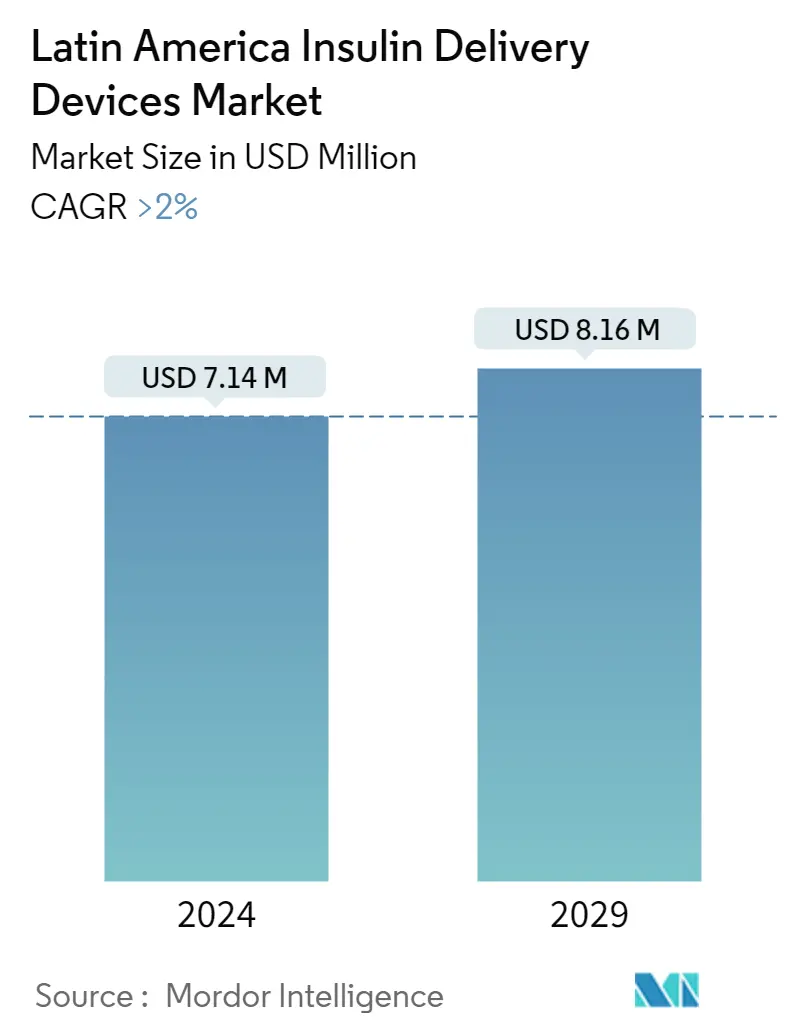
| Study Period | 2019 - 2029 |
| Base Year For Estimation | 2023 |
| Forecast Data Period | 2024 - 2029 |
| Market Size (2024) | USD 7.14 Million |
| Market Size (2029) | USD 8.16 Million |
| CAGR (2024 - 2029) | 2.00 % |
Major Players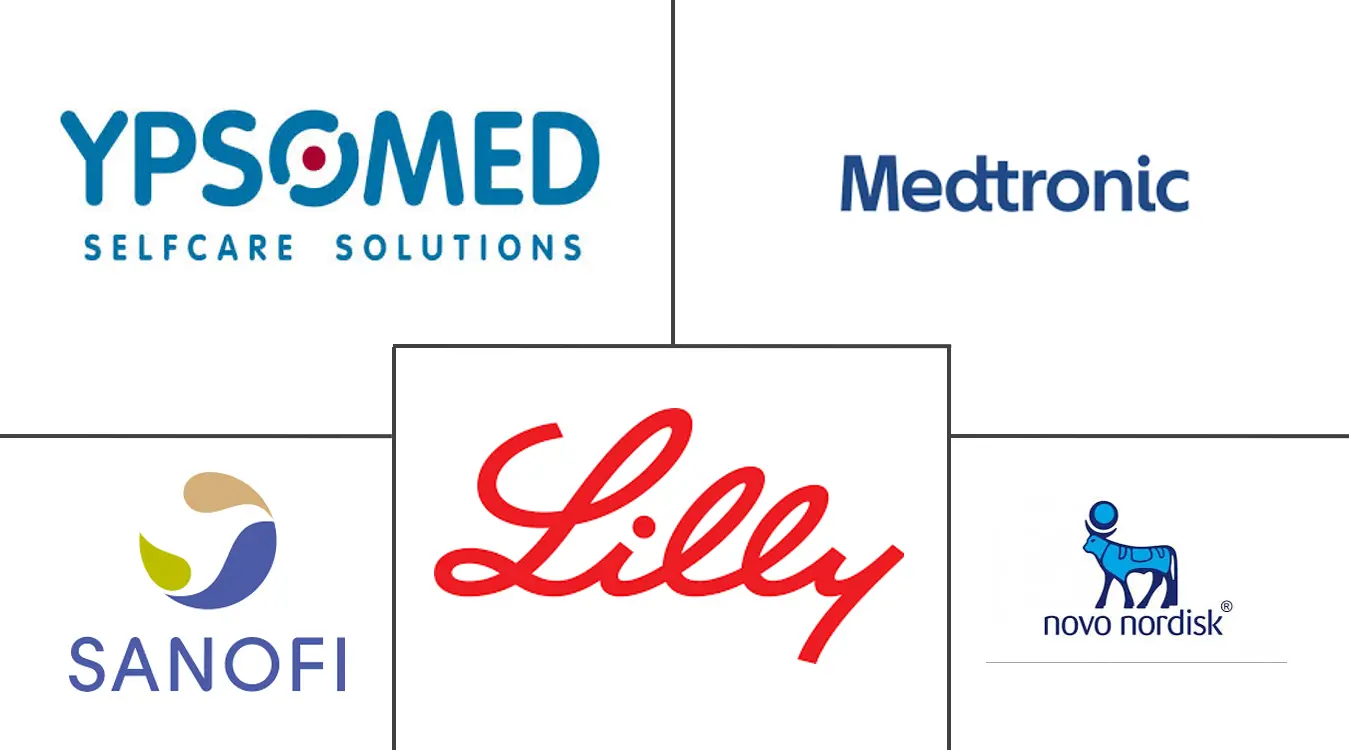
*Disclaimer: Major Players sorted in no particular order |
Latin America Insulin Delivery Devices Market Analysis
The Latin America Insulin Delivery Devices Market size is estimated at USD 7.14 million in 2024, and is expected to reach USD 8.16 million by 2029, growing at a CAGR of greater than 2% during the forecast period (2024-2029).
The pandemic that everyone was talking about before COVID-19, is a challenge to health systems and a threat to their financial viability. The improper use of corticosteroids and the presence of diabetes mellitus in patients during the Coronavirus Disease 2019 (COVID-19) pandemic marked the beginning of an increased incidence of fungal infections such as aspergillosis and mucormycosis in patients with this emerging viral infection. More than 200 cases have been reported in the literature in Latin America, ranging from Mexico to Argentina. The majority of cases have come from Brazil. Prior to COVID-19, the number of cases had been increasing while the mortality rate had been decreasing. Access to telemedicine is critical for managing chronic diseases in children, such as type 1 diabetes.
Telemedicine was implemented in Latin American countries due to the COVID-19 pandemic, which positively impacted the health system. Telemedicine could result in financial savings by avoiding transportation expenses, class and parental working hours lost, time lost for transportation to distant referral health centres, and improving the quality of life, socioeconomic level, and environment."
Diabetes is one of the major health challenges of the twenty-first century, according to the Pan American Health Organization (PAHO). According to the organization's data, the number of people suffering from this condition will reach 642 million by 2040. One advantage of this solution is that it allows patients to communicate with a remote healthcare professional, avoiding the need to visit a healthcare facility and lowering the risk of contracting COVID-19 in this high-risk group. Diabetes affects approximately 41 million people in Latin America and 400 million worldwide. This figure is expected to rise over time, reaching 68 million diabetics in the region by 2040.
Technological advancements have increased over the period in Insulin delivery devices for safer and more accurate administration of insulin. In 2020, Medtronic launched its first integrated smart insulin pen. The Medtronic Integrated Insulin Pen provides real-time glucose readings of patients along with insulin dose information to manage their glucose levels.
The world is facing an unprecedented global health crisis, and it is critical that we support the implementation of technological solutions, such as Insulin devices, to collaborate on regional growth and continue to support the millions of people living with this condition.
Latin America Insulin Delivery Devices Market Trends
Insulin Pump is Expected to Witness Growth Over the Forecast Period
An insulin pump is a device that automatically delivers insulin on a continuous or as-needed basis. The pump is modeled after the human pancreas. The insulin infusion pump can be used instead of the traditional system of daily injections or an insulin pen. Insulin Pumps accounted for 15% of the insulin delivery devices market in the current year. It is expected to grow at a CAGR greater than 6.2% due to increasing technological advancement and its preference over other traditional methods due to continuous insulin administration. According to a new study presented on June 2022 at ENDO 2022, there have been few improvements in ethnic, racial, and socioeconomic inequities in insulin pump use among youth with type 1 diabetes over the past 20 years, despite an overall increase in the use of insulin pumps.
Insulin pump therapy is a well-established method of insulin administration for people with type 1 diabetes (T1DM). Pumps are a validated, time-tested therapeutic option for T1DM patients of all ages, enabling near-physiological insulin delivery when the pancreas does not produce insulin. Even pump models with remote controls allow parents to suspend or bolus insulin from a distance while their child is playing or eating.
Compared to injections, insulin infusion pumps reduce large swings in blood glucose levels, cause less pain, and deliver more accurately. The advantages of insulin pumps over traditional delivery systems are expected to drive market growth.
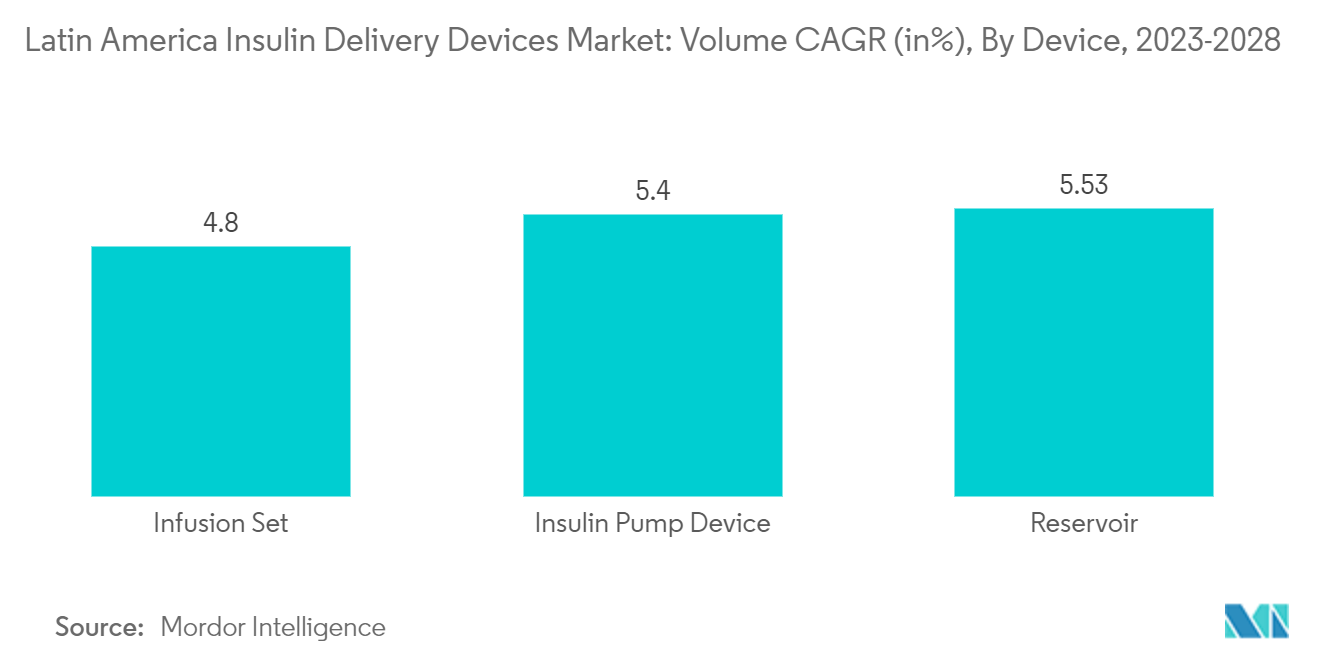
Brazil is Expected to Dominate the Latin America Insulin Delivery Devices Market
Brazil is expected to dominate the market due to factors such as the easy availability of insulin delivery devices and high consumer awareness.
The Brazilian health system is managed by each state and local health secretariat and is governed by the MOH. Furthermore, in many towns where the public sector cannot meet people's needs, partnerships with private organizations to increase access to PHC have been established. The Brazilian health system covers medicines through several programs, including a 20% increase in access to essential medicines. Brazil has an extensive free immunization program. Over the last 20 years, Brazil has faced numerous lawsuits demanding coverage of high-cost drugs to treat diabetes and other rare or low-prevalence diseases. The diabetic population in Brazil is expected to grow by 74% between 2017 and 2045. Brazil is currently the world's sixth most populous country, with the fourth highest prevalence of diabetes. The Brazilian government is encouraging diabetes patients to take the medication to reduce the country's death rate. The Brazilian Ministry of Health collaborated with private pharmacies in Brazil to provide diabetes patients with two types of insulin (regular human insulin and isophane insulin or NPH) and three oral antidiabetic medications (5 mg glibenclamide and 500 and 850 mg metformin) for free.
According to a Brazilian survey, 38.4% of people with diabetes are delaying medical appointments or laboratory tests, and 5.8% have stopped reclaiming their medicines and medical supplies for diabetes self-care. The potential consequences of these fears on diabetic populations can be catastrophic, increasing the already high incidence of chronic complications and exacerbating their risk of becoming infected with SARS-CoV-2. Thus, among the immediate protective measures to be implemented, the government began telehealth, teleconsultation, and other online strategies to address the challenges of healthcare professional shortages while keeping people with diabetes protected and assisted.
Therefore, owing to the factors above, the growth of the studied market is anticipated in the Latin America Region.
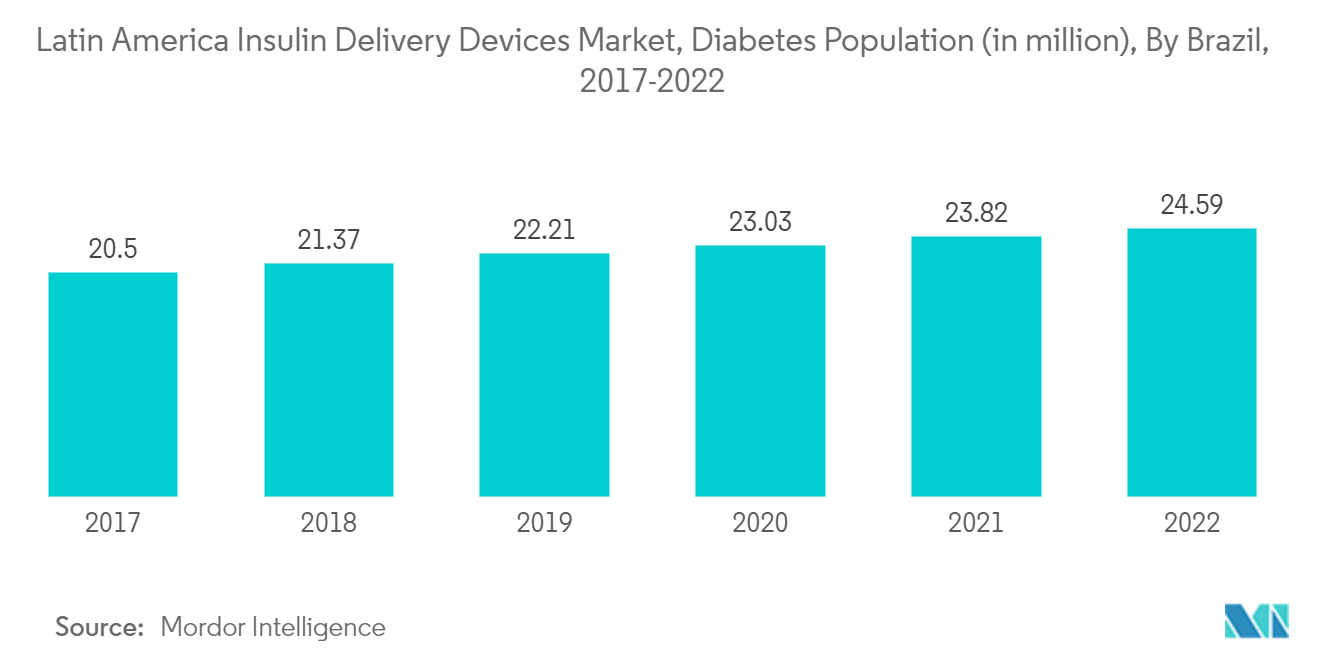
Latin America Insulin Delivery Devices Industry Overview
The insulin delivery devices market is consolidated due to only a few major companies operating globally and regionally. The competitive landscape includes analyzing a few international and local companies that hold market shares and are well known, including Novo Nordisk, Sanofi, Eli Lily and Company, Medtronic, Insulet, Ypsomed, Becton Dickinson, and Company, among others.
Latin America Insulin Delivery Devices Market Leaders
-
Ypsomed
-
Medtronic
-
Sanofi
-
Eli Lilly
-
Novo Nordisk
*Disclaimer: Major Players sorted in no particular order
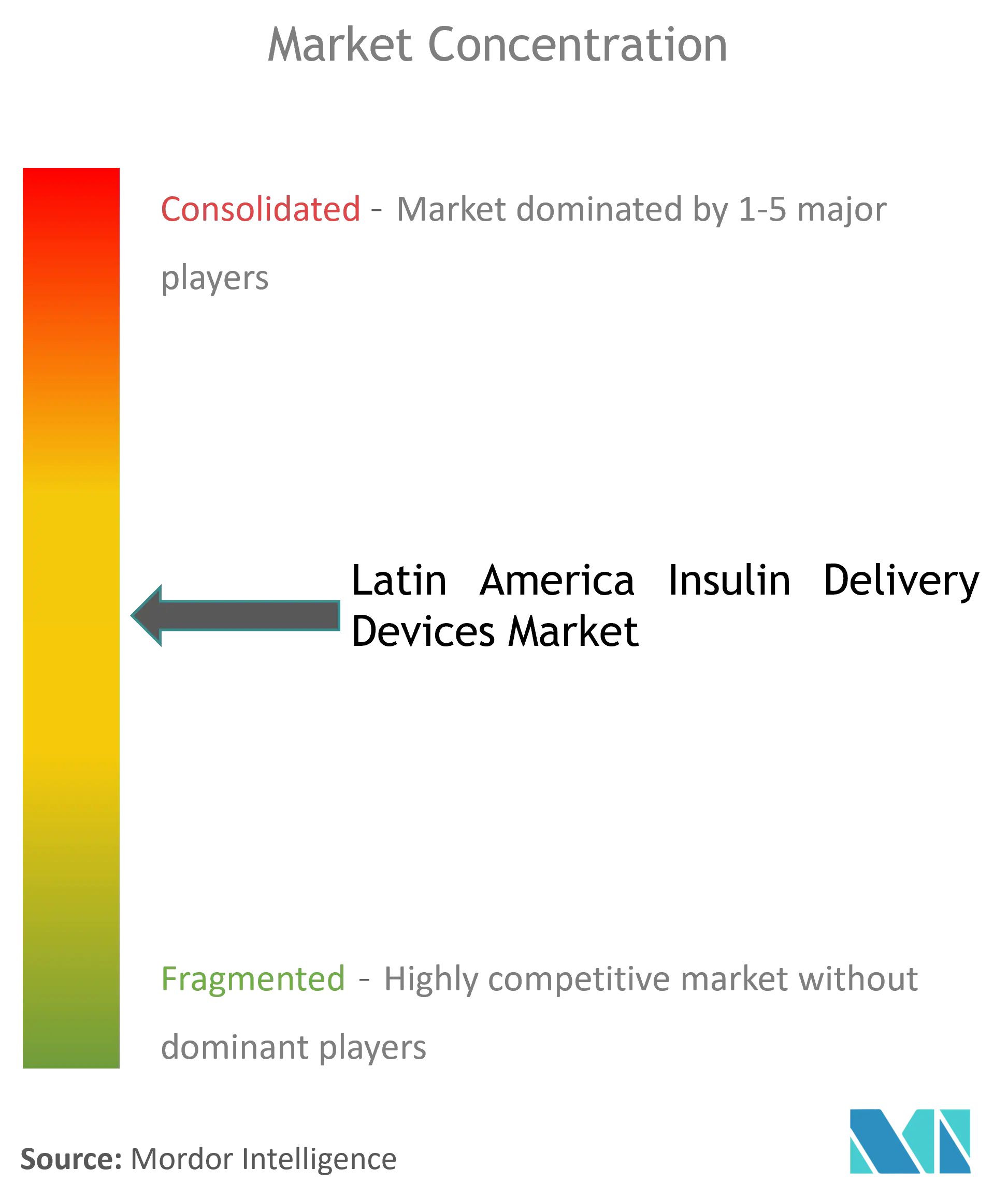
Latin America Insulin Delivery Devices Market News
- March 2022: Novo Nordisk announced that two smart connected insulin pens, NovoPen 6 and NovoPen Echo Plus, were available on prescription for people with diabetes treated with Novo Nordisk insulin in the United Kingdom.
- January 2022: Boston-based Insulet Corp. announced that the FDA (Food and Drug Administration) cleared the new Omnipod 5 system, marking the company's entry into the automated insulin delivery (AID) universe.
Latin America Insulin Delivery Devices Market Report - Table of Contents
1. INTRODUCTION
- 1.1 Study Assumptions and Market Definition
- 1.2 Scope of the Study
2. RESEARCH METHODOLOGY
3. EXECUTIVE SUMMARY
4. MARKET DYNAMICS
- 4.1 Market Overview
- 4.2 Drivers
- 4.3 Restraints
-
4.4 Porter's Five Forces Analysis
- 4.4.1 Bargaining Power of Suppliers
- 4.4.2 Bargaining Power of Consumers
- 4.4.3 Threat of New Entrants
- 4.4.4 Threat of Substitute Products and Services
- 4.4.5 Intensity of Competitive Rivalry
5. Market Segmentation
-
5.1 Device
- 5.1.1 Insulin Pump
- 5.1.1.1 Technology
- 5.1.1.1.1 Tethered Insulin Pump
- 5.1.1.1.2 Tubeless Insulin Pump
- 5.1.1.2 Component
- 5.1.1.2.1 Insulin Pump Devices
- 5.1.1.2.2 Insulin Pump Reservoirs
- 5.1.1.2.3 Infusion Sets
- 5.1.2 Insulin pens
- 5.1.2.1 Cartridges in reusable pens
- 5.1.2.2 Disposable Pens
- 5.1.3 Insulin Syringes
- 5.1.4 Jet Injectors
-
5.2 Geography
- 5.2.1 Brazil
- 5.2.2 Mexico
- 5.2.3 Rest of North America
6. MARKET INDICATORS
- 6.1 Type-1 Diabetes Population
- 6.2 Type-2 Diabetes Population
7. COMPETITIVE LANDSCAPE
-
7.1 Company Profiles
- 7.1.1 Novo Nordisk AS
- 7.1.2 Sanofi SA
- 7.1.3 Eli Lilly and Company
- 7.1.4 Medtronic PLC
- 7.1.5 Insulet corporation
- 7.1.6 Ypsomed
- 7.1.7 Becton, Dickinson and Company
- 7.1.8 Other Key Players
- *List Not Exhaustive
- 7.2 Company Share Analysis
8. MARKET OPPORTUNITIES AND FUTURE TRENDS
** Subject To AvailablityLatin America Insulin Delivery Devices Industry Segmentation
There are several choices for delivering insulin to people with diabetes, including syringes, pens, pumps, and jet injectors. A syringe is a tool having a detachable needle guard, plunger, and hollow center. Latin America Insulin Delivery Devices Market is segmented by Device (Insulin Pumps, Insulin Syringes, Cartridges in Reusable Pens, Disposable Pens, Jet Injectors) and Geography (Mexico, Brazil, and the Rest of Latin America). The report offers the value (in USD) and Volume (in Unit) for the above segments. We will provide a segment-wise breakdown (Value and Volume) for all the countries covered under the Table of Contents.
| Device | Insulin Pump | Technology | Tethered Insulin Pump |
| Tubeless Insulin Pump | |||
| Device | Insulin Pump | Component | Insulin Pump Devices |
| Insulin Pump Reservoirs | |||
| Infusion Sets | |||
| Device | Insulin pens | Cartridges in reusable pens | |
| Disposable Pens | |||
| Device | Insulin Syringes | ||
| Jet Injectors | |||
| Geography | Brazil | ||
| Mexico | |||
| Rest of North America |
Latin America Insulin Delivery Devices Market Research FAQs
How big is the Latin America Insulin Delivery Devices Market?
The Latin America Insulin Delivery Devices Market size is expected to reach USD 7.14 million in 2024 and grow at a CAGR of greater than 2% to reach USD 8.16 million by 2029.
What is the current Latin America Insulin Delivery Devices Market size?
In 2024, the Latin America Insulin Delivery Devices Market size is expected to reach USD 7.14 million.
Who are the key players in Latin America Insulin Delivery Devices Market?
Ypsomed, Medtronic, Sanofi, Eli Lilly and Novo Nordisk are the major companies operating in the Latin America Insulin Delivery Devices Market.
What years does this Latin America Insulin Delivery Devices Market cover, and what was the market size in 2023?
In 2023, the Latin America Insulin Delivery Devices Market size was estimated at USD 7 million. The report covers the Latin America Insulin Delivery Devices Market historical market size for years: 2019, 2020, 2021, 2022 and 2023. The report also forecasts the Latin America Insulin Delivery Devices Market size for years: 2024, 2025, 2026, 2027, 2028 and 2029.
Latin America Insulin Delivery Devices Industry Report
Statistics for the 2024 Latin America Insulin Delivery Devices market share, size and revenue growth rate, created by Mordor Intelligence™ Industry Reports. Latin America Insulin Delivery Devices analysis includes a market forecast outlook 2029 and historical overview. Get a sample of this industry analysis as a free report PDF download.



